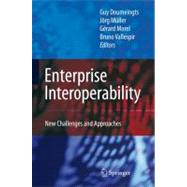
What is included with this book?
| Service-oriented Interoperability Approaches | |
| Development of Dynamic Composed Services Based on the Context | p. 3 |
| Semantics of Interoperable and Outsourced Information Systems | p. 13 |
| A Platform Independent Model for Service Oriented Architectures | p. 23 |
| Enterprise Interoperability Architecture | |
| Formalizing Analysis of Enterprise Architecture | p. 35 |
| To Adapt or Not to Adapt, That is the Question: Towards a Framework to Analyze Scenarios for Aligning Legacy and Business Components | p. 45 |
| Value object analysis and the transformation from value model to process model | p. 55 |
| Activity Diagram Based Process Family Architectures for Enterprise Application Families | p. 67 |
| Model-driven Approaches to Interoperability | |
| An Integrated Model-driven Service Engineering Environment | p. 79 |
| UML for Enterprise Modelling: basis for a Model-Driven Approach | p. 91 |
| Solving Problems in the Parameterisation of ERPs Using a Model-Driven Approach | p. 103 |
| A Decentralized Broker Architecture for Collaborative Business Process Modelling and Enactment | p. 115 |
| Methods, Models, Languages and Tools for Enterprise Interoperability | |
| Discretization of Continuous Features by Using a Kernel | p. 129 |
| Designing and Implementing Cross-Organizational Business Processes - Description and Application of a Modelling Framework | p. 137 |
| Quality Criteria for Enterprise Modelling in the Context of Networked Enterprises | p. 149 |
| The UEML Approach to Modelling Construct Description | p. 159 |
| A Roadmap for UEML | p. 169 |
| An Interoperable Platform to Implement Collaborative Forecasting in OEM Supply Chains | p. 179 |
| Service- and Process-Matching - An Approach towards Interoperability Design and Implementation of Business Networks | p. 189 |
| Achieving Enterprise Model Interoperability Applying a Common Enterprise Metamodel | p. 199 |
| Interoperability Characterization Using Enterprise Modeling and Graph Representation | p. 209 |
| Semantics and Ontology-based Interoperability | |
| Semantic Service Modeling: Enabling System Interoperability | p. 221 |
| Supporting Scientific Collaboration in a Network of Excellence Through a Semantically Indexed Knowledge Map | p. 231 |
| Mapping XML Schema to OWL | p. 243 |
| Extending OWL-S to Solve Enterprise Application Integration Issues | p. 253 |
| Practical Issues in Ontology Modeling: The Case of Defence Conceptual Modeling Framework-Ontology | p. 265 |
| Digital Resource Discovery: Semantic Annotation and Matching Techniques | p. 275 |
| A Model for Assessing the Impact of Enterprise Application Interoperability in the Typical European Enterprise | p. 287 |
| Ontology-based Transformations for Achieving Interoperability in AmI | p. 297 |
| Interoperability of Decision Models | |
| A Decentralized Approach for Inter-Enterprise Business Process Collaboration | p. 309 |
| Towards a Conceptualization of Decisional Interoperability | p. 321 |
| Interoperability and Synergism of Decision, Information and Flexibility to Improve Performances of Enterprise Systems: KM Implications | p. 331 |
| Inter-organisational Interoperability | |
| Service Typing in Collaborative Systems | p. 343 |
| Decentralized Metadata Development for Open B2B Electronic Business | p. 355 |
| The TrustCoM Approach to Enforcing Agreements between Interoperating Enterprises | p. 365 |
| Organisational Inter-operability: Towards Enterprise Urbanism | p. 377 |
| An Integrated Approach for Organizational Data Interoperability | p. 387 |
| Managing the Lifecycle of Cross-organizational Collaborative Business Processes | p. 397 |
| Interoperability through Model-based Generation: The Case of the Collaborative Information System (CIS) | p. 407 |
| A Natural Basis for Interoperability | p. 417 |
| Designing a Modular Infrastructure for Exploratory Integration of Interoperability Approaches | p. 427 |
| Interoperability of Manufacturing Enterprise Applications | |
| Supply Chain Management System and Interoperability through EAI Platform | p. 441 |
| Enhancing Interoperability of Manufacturing Software Units Using Capability Profiling | p. 451 |
| Towards a Product Oriented Process Modelling for Enteriprise Applications Synchronisation and Interoperability | p. 461 |
| Business Models Interoperability | |
| Developing Interoperable Business Processes Using Web Services and Policies | p. 475 |
| Talea: An Extensible Framework for E-Business Integration | p. 489 |
| A Complexity Based Approach to Collaborations in the Tool and Die Industry | p. 499 |
| Modelling Inter-organizational Workflow Security in a Peer-to-Peer Environment | p. 509 |
| Enterprise Software with Half-Duplex Interoperations | p. 521 |
| e-Proc a TO BE Scenario for Business Interoperability | p. 531 |
| Standards for Interoperability | |
| ICT Standards Development - Finding the Best Platform | p. 543 |
| Experts on Causes of Incompatibility between Standard-Compliant Products | p. 553 |
| Achieving Influence on Standardisation Bodies | p. 565 |
| Interoperability in Healthcare: Standards for the French Project of a National Personal Medical Card | p. 575 |
| Index of Contributors | p. 585 |
| Table of Contents provided by Publisher. All Rights Reserved. |
The New copy of this book will include any supplemental materials advertised. Please check the title of the book to determine if it should include any access cards, study guides, lab manuals, CDs, etc.
The Used, Rental and eBook copies of this book are not guaranteed to include any supplemental materials. Typically, only the book itself is included. This is true even if the title states it includes any access cards, study guides, lab manuals, CDs, etc.